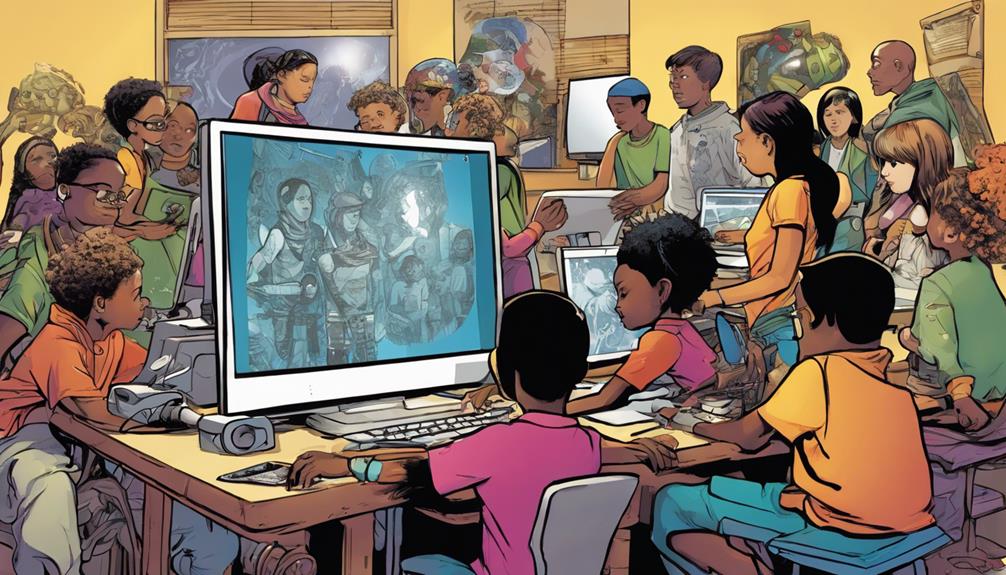Creating an advanced baby stimulation plan means choosing activities and toys that support your child's cognitive, emotional, and physical development. Start with simple games like peekaboo to build social engagement. For infants 3-6 months, incorporate textured books and soft toys for sensory play. As they grow, introduce interactive toys that promote fine motor skills and problem-solving. Encourage solo play in a safe space, rotating toys to keep their curiosity alive. Don't forget to integrate engaging storytime routines to enhance language skills. There's so much more to explore about enriching your baby's play experience and promoting growth.
Key Takeaways
- Incorporate varied sensory experiences through textured toys and auditory stimulation to enhance cognitive and motor development in babies.
- Engage in regular tummy time and varied positioning to promote muscle strength, coordination, and spatial awareness from an early age.
- Utilize interactive and cause-and-effect toys to foster problem-solving skills and encourage independent play in infants aged 6-12 months.
- Read lively, textured cloth books and recite nursery rhymes to support language acquisition and early literacy in babies aged 3-6 months.
- Rotate toys and create a safe exploration space to maintain curiosity and encourage experimentation during independent playtime.
Importance of Play for Development
Play is absolutely fundamental for your baby's development, shaping their cognitive, emotional, and social skills. When you engage in various play activities with your little one, you're not just having fun; you're also enhancing their cognitive development. Simple games like peekaboo teach foundational concepts like absence and presence, which lay the groundwork for object permanence. These interactions help your baby understand the world around them, fostering a stronger relationship between you and your child.
Engaging in structured play introduces your baby to organized activities that can further enhance their learning and development.
Every moment spent playing is a chance for your baby to learn. Research shows that varied play experiences stimulate the creation of millions of neural connections in their brains, greatly influencing cognitive growth and emotional security. The back-and-forth interactions you share during play are essential, as they provide crucial information for your baby's understanding and learning.
A warm and responsive relationship with you, nurtured through play, serves as a key foundation for your child's overall development. By prioritizing play, you're not only enriching your baby's cognitive abilities but also enhancing emotional and social skills that will benefit them throughout childhood.
Embrace these moments; they're significant for your baby's growth.
Cognitive Milestones for Infants

As your baby engages in play, they're also hitting important cognitive milestones that shape their understanding of the world. From birth, they recognize your voice, which is vital for forming strong emotional bonds.
Around 3-6 months, you'll notice your baby cooing and responding to sounds, marking the early stages of their communication skills. Engaging in play with pets, such as dogs, can also enhance these interactions, as babies often enjoy observing and mimicking the actions of animals, which can aid in their social development and emotional learning, especially if you have a dog breed that promotes social engagement.
By 6-9 months, they might start saying "mama" or "dada" appropriately and responding to simple instructions. This is a sign of their growing cognitive comprehension.
As they reach 9-12 months, your little one will enjoy repetitive games and experiment with cause and effect—like throwing objects to see what happens—showcasing their developing problem-solving abilities.
Engaging in back-and-forth interactions, like peekaboo, is key for their cognitive development. These activities help your baby learn concepts of absence and presence while fostering social engagement.
To support this growth, incorporate activities with your baby that encourage communication and exploration. Remember, the more you engage your baby in play and cognitive activities, the better equipped they'll be to navigate their world and develop essential skills.
Engaging Play Ideas for 3-6 Months

At this stage, your baby thrives on engaging activities that stimulate their senses and foster development. Incorporating different play activities into your routine can greatly enhance their cognitive development and motor skills.
Reflect on integrating various baby books that promote early literacy while making playtime enjoyable. Here are three fun ideas to reflect on:
- Reading and Singing: Use textured cloth books to read and sing nursery rhymes. This activity not only boosts language skills but also provides sensory stimulation as your baby interacts with the textures.
- Ball Play: Provide your little one with various balls to hold, drop, and roll. This encourages movement exploration and helps develop their motor skills while keeping them engaged.
- Tactile Exploration: Introduce soft toys with different textures and sounds, such as rattles and bells. These toys stimulate your baby's auditory senses and encourage interaction, making playtime both fun and educational.
Fun Activities for 6-12 Months

Once your baby reaches the 6-12 month mark, they're ready for a new level of exploration and discovery. This is the perfect time to introduce a variety of fun activities that promote cognitive development and enhance their skills.
Creative parenting workshop ideas can provide inspiration for engaging activities tailored to your baby's needs. Bath time can become an exciting play session with dunking, measuring, floating, and pouring bath toys. These activities not only stimulate sensory exploration but also help improve fine motor skills.
Interactive toys featuring buttons for shaking and banging will engage your baby's curiosity, promoting auditory stimulation and hand-eye coordination as they experiment with cause and effect. Stacking blocks and rolling toys can further support fine motor skills while encouraging problem-solving as your little one learns to manipulate objects.
Don't forget the power of reading! Engage in lively reading sessions using varied voices and animal sounds. This not only captivates attention but also enhances language acquisition through repetition and engagement.
Supporting Independent Play

Independent play is an essential part of your baby's development, allowing them to explore their surroundings and build confidence in their abilities.
By supporting independent play, you help foster cognitive development and problem-solving skills, which are vital as they grow. Engaging in independent play can also contribute to a balanced lifestyle, as it promotes both mental and physical growth.
Here are three key ways to promote this:
- Create a safe and stimulating space: Make sure your baby has a designated area filled with age-appropriate toys that encourage exploration and creativity. Incorporating elements that align with healthy lifestyle blogs can provide additional inspiration for creating an engaging environment.
- Encourage solo play: Allow your baby to engage in solo play, stepping back occasionally to give them room to experiment and discover solutions independently. This reinforces their problem-solving skills.
- Rotate toys regularly: Keep playtime fresh and exciting by introducing new toys or rotating existing ones. This maintains their interest and fuels their curiosity to explore their environment.
Enhancing Visual and Auditory Skills

As your baby explores through independent play, enhancing their visual and auditory skills becomes equally important. Focus on visual perception development by introducing high-contrast images. These images capture your baby's attention, as they primarily rely on their eyesight for information until around five months of age. Engaging toys like colorful mobiles and black-and-white cards encourage visual tracking and cognitive development.
Additionally, the use of essential oils, such as lavender, can create a calming environment that supports relaxation during playtime, promoting a more focused exploration of their surroundings, fostering their sense of aromatherapy benefits.
Incorporate auditory stimulation into your baby's environment to create a calming atmosphere. They show a preference for a single human voice, so soft, rhythmic sounds and gentle singing can be particularly soothing. Simple sound-making activities, like rattling or tapping, not only capture their attention but also support neural development through auditory exploration.
Moreover, integrating varied musical exposure into daily routines can greatly aid in your baby's growth. Babies respond positively to rhythm and melody, fostering emotional bonding and enhancing language skills.
Promoting Physical Development

To promote your baby's physical development, incorporating tummy time is essential for building important neck and back muscles.
You should also explore varied positioning throughout the day, as this helps strengthen muscles and enhances spatial awareness.
Tummy Time Techniques
Tummy time is a significant activity that helps your baby develop essential neck, shoulder, and back muscles needed for future milestones like crawling and walking.
The American Academy of Pediatrics recommends starting tummy time as early as the first week after birth, gradually increasing the duration to 20-30 minutes per day by the time your baby is three months old.
Incorporating tummy time into your routine not only promotes physical development but also stimulates your baby's brain.
Here are three engaging tummy time techniques to take into account:
- Incorporate Stimulating Toys: Use high-contrast images or mirrors to encourage your baby to lift their head, making the experience more fun and engaging.
- Chest Time: Place your baby on your chest during tummy time. This creates a bonding moment while still promoting essential physical development.
- Vary the Surface: Try different surfaces, like a soft blanket or a play mat, to keep the activity interesting and prevent your baby from getting bored.
Varied Positioning Benefits
How can varying your baby's positions throughout the day enhance their physical development? By incorporating varied positioning benefits, you're promoting muscle strength and coordination necessary for mobility. Regularly changing your baby's position—like tummy time, side lying, and sitting—can prevent flat spots on the head and support healthy head shape development.
Engaging your baby in different positions not only builds muscle but also enhances spatial awareness, encouraging exploration of their environment. Using props like rolled blankets for side lying can safely strengthen back and belly muscles, while baby carriers allow for upright play, balancing movement with comfort.
Here's a quick reference table to illustrate the benefits:
| Position | Benefits | Tips for Implementation |
|---|---|---|
| Tummy Time | Builds neck and shoulder strength | Use toys to engage and motivate |
| Side Lying | Enhances muscle control | Support with rolled blankets |
| Sitting | Promotes balance and stability | Use a cushion for safety |
| Upright Play | Boosts spatial awareness | Utilize baby carriers for comfort |
Incorporating different textures during play can also stimulate cognitive development, making each position an opportunity for growth.
Tactile Experiences and Fine Motor Skills

Tactile experiences play an essential role in your baby's development, boosting both sensory exploration and fine motor skills.
By introducing textured fabrics, rattles, and sensory balls, you encourage your little one to grasp and manipulate objects, enhancing their hand-eye coordination.
Engaging with interactive preschool role-play toys can further support imaginative play and creativity.
Activities like finger painting and water play not only strengthen hand muscles but also spark curiosity about their environment.
Sensory Play Activities
Engaging in sensory play activities is essential for your baby's development, as it enhances their tactile experiences and fine motor skills.
These activities provide opportunities for exploration and encourage problem-solving while stimulating cognitive development.
Here are three sensory play activities you can try:
- Water Play: Let your baby splash around in a shallow tub filled with water. Introduce floating toys for them to grasp and manipulate, promoting hand-eye coordination and dexterity.
- Textured Exploration: Use soft toys, textured cloth books, and various fabrics. Allow your baby to touch and feel different textures, which helps develop their tactile experiences and fine motor skills.
- Playdough Fun: Introduce safe playdough for your baby to pinch, roll, and shape. This manipulative play encourages exploration and strengthens fine motor skills through grasping and pinching.
Fine Motor Development
Sensory play activities naturally lead to important developments in fine motor skills. By engaging your baby with varied textured fabrics and toys, you enhance their tactile experiences and promote sensory awareness. As they grasp, shake, and manipulate rattles and soft toys, they practice reaching and gripping, which are essential for developing hand-eye coordination.
Introducing stacking blocks and nesting cups is another fantastic way to aid fine motor skills. Your little one learns to fit objects together, exploring cause and effect in the process.
Activities like water play, where infants can splash and pour, not only strengthen grip and coordination but also offer rich sensory stimulation.
Encouraging your infant to participate in simple tasks, like sorting objects by size or color, can further foster cognitive development alongside fine motor skill improvement. These activities not only build dexterity but also enhance problem-solving abilities.
Integrating Reading Into Playtime

Reading can be a delightful addition to playtime, transforming ordinary moments into rich learning experiences. Integrating reading supports your baby's cognitive development while deepening your relationship through shared activities. Here are three ways to incorporate reading into playtime:
- Use books with vibrant images: Picture books capture your baby's attention, helping them associate words with visuals.
- Recite nursery rhymes and sing songs: The rhythm and repetition enhance language acquisition, making it fun and engaging.
- Encourage sensory exploration: Choose tactile books that allow your baby to feel different textures, stimulating their senses.
Allowing your infant to lead the way during reading sessions fosters autonomy and a love for storytelling.
When you consistently integrate reading into daily routines—like before naps or mealtimes—it creates a predictable environment that supports emotional security.
Engaging with varied voices and sound effects not only entertains but also strengthens the emotional bond between you and your baby.
Building a Home Library for Babies

Building a home library for your baby is a fun and essential step in fostering a love for reading. Start by selecting age-appropriate books and creating cozy reading nooks that invite exploration and engagement.
Consider incorporating a variety of storytelling methods, such as interactive Island Getaways or themed storytime sessions, to make the experience even more enriching. You can enhance the experience with engaging reading activities that make storytime a cherished part of your daily routine.
Selecting Age-Appropriate Books
Creating a cozy home library for your baby can set the stage for a lifelong love of books. Selecting age-appropriate books is essential for their development. Here are three types of books to take into account:
- Colorful Board Books: These foster early literacy and engage your infant's attention, laying the foundation for vocabulary development.
- Touch-and-Feel Books: These enhance hand-eye coordination and sensory exploration, which are important for cognitive development by giving your baby new experiences to explore.
- Interactive Stories: Look for books with flaps or textures to keep them engaged, making reading a fun and interactive activity.
It's good to try plenty of diverse titles, as access to various books encourages regular reading habits.
Research shows that reading aloud during pregnancy can benefit language recognition post-birth, emphasizing the significance of establishing these habits early.
Collaborations, like those between Scholastic and Reach Out and Read, curate high-quality, inclusive titles designed to support infants' developmental milestones.
Creating Cozy Reading Nooks
Transform your baby's space into a cozy reading nook that invites exploration and wonder. Use soft cushions, blankets, and low lighting to create a comfortable environment where your little one can engage with colorful board books and interactive stories. This setup not only fosters a love for reading but also stimulates cognitive development, helping your baby recognize words and sounds.
Incorporate touch-and-feel books to enhance sensory exploration, making reading a multi-sensory experience. These tactile elements improve hand-eye coordination while keeping your infant intrigued. By selecting a variety of vibrant books, you can capture their attention and encourage them to reach out and explore.
Establishing a cozy corner for reading promotes literacy skills and strengthens emotional bonds between you and your baby. Regular shared reading experiences create cherished moments that lay the foundation for a lifelong love of books.
Plus, reading together during pregnancy can benefit language recognition after birth, ensuring your baby feels a positive connection with books from the start.
Creating a dedicated reading nook is an essential step in building a home library that nurtures your baby's development and fosters a warm, loving environment.
Engaging Reading Activities
A home library brimming with engaging reading activities can ignite your baby's curiosity and foster a lifelong love for books. By creating a vibrant space filled with diverse reading materials, you can enhance early literacy skills while making reading a delightful part of your daily routine.
Here are three important components for your home library:
- Colorful Board Books: Choose titles with bright illustrations to captivate your baby's attention and stimulate sensory exploration.
- Touch-and-Feel Books: These interactive stories not only entertain but also promote hand-eye coordination, essential for cognitive development.
- Personalized Storytelling: Incorporate your baby's name or familiar characters to make reading aloud more engaging and relatable.
Reading aloud is fundamental, even during pregnancy, as it enhances language recognition and strengthens your bond.
Establishing regular reading routines, including repetition of favorite titles, will encourage your little one to develop a preference for books, supporting vocabulary growth.
Remember, the more you read together, the more your baby will thrive in their journey of baby play and exploration.
Frequently Asked Questions
How Do You Stimulate an Advanced Baby?
To stimulate an advanced baby, you can use high-contrast toys and images to capture their attention and enhance visual tracking.
Incorporate different textures and sounds through rattles and fabric books to promote sensory exploration.
Engage in tummy time to strengthen their core muscles.
Play interactive games like peekaboo to foster problem-solving skills, and read aloud with varied expressions to boost language acquisition and emotional connection.
These activities support their overall development effectively.
What Kind of Toys or Experiences Would Help Stimulate the Baby's Brain Development?
Think of toys as the keys to a treasure chest, revealing your baby's potential.
To stimulate brain development, choose high-contrast toys that catch their eye, and rattles or bells that engage their ears.
Interactive toys with buttons teach cause and effect, while textured items invite tactile exploration.
Stacking blocks or rolling toys can promote independent problem-solving and movement.
How Do You Create a Stimulating Environment for Babies?
To create a stimulating environment for your baby, focus on safety and engagement.
Set up a cozy space filled with age-appropriate toys like textured books and colorful mobiles. Incorporate soothing sounds and gentle voices to keep the atmosphere calm.
Provide plenty of tummy time and safe areas for movement to promote physical development.
What Are the Techniques for Infant Stimulation?
So you think your baby needs stimulation? Well, let's throw them into a world of colors, sounds, and endless chatter!
Sing, talk, and read to them—who needs silence, right? Flash some high-contrast images to keep those little eyes entertained.
Play peekaboo like it's an Olympic sport! Don't forget to offer different textures for those tiny fingers.
Just remember: the more you engage, the more curious they'll be. Happy stimulating!
Conclusion
In nurturing your baby's growth, think of play as a vibrant garden, where each activity is a seed planted in fertile soil. As you cultivate these experiences, watch your little one blossom into a curious explorer. By integrating these engaging activities and a treasure trove of stories, you're not just supporting development; you're weaving a tapestry of joy and learning. Embrace this journey, and let your baby's imagination soar like a kite in the open sky, boundless and free.










